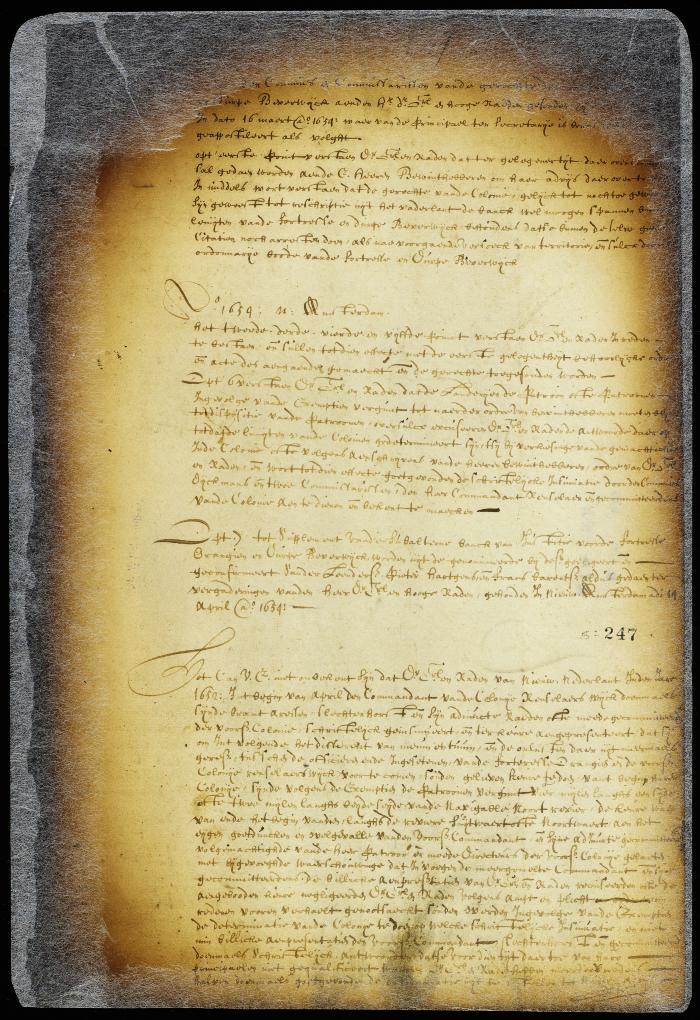1654, New Amsterdam.
The director-general and council consider the second, third, fourth and fifth points to be reasonable and shall therefore transmit to the court proper orders and documents, drawn up for this purpose, as soon as possible.
Concerning the sixth, the director-general and council allow that the lands granted to the patroon or patroons, according to the exemptions,[1] must remain at their disposal until further orders from the lords-directors. Therefore, the director-general and council refuse to reply thereto until the limits of the Colony have been determined either by the decision of the authorities in the Colony or by an order of the director-general and council pursuant to the instructions of the lords-directors, and consequently it has been resolved that the commissary, Dyckmans, and two magistrates serve the written summons to the commander, Renselaer[2] and the officials of the Colony.
Concerning the seventh point for completing the inferior court of justice for Fort Orange and the village of Beverwyck; the following names have been selected from the submitted lists Sander Leendersz, Pieter Hartgens and Frans Barentsz. Thus done at the session of the director-general and high council held in New Amsterdam, 14 April 1654.
Your honors cannot be ignorant of the fact that the director-general and council of New Netherland wrote in the beginning of April of 1652 to the commander of the colony of Renselaerswyck, at that time Brant Aressen Slechtenhorst, and his fellow councilors or magistrates,[3] giving them the choice of selecting the starting point of the boundaries of the Colony so that in the future the arguments about meum et tuum and the quarrels, which have arisen because of it between the officers and inhabitants of Fort Orange and the people of the aforesaid Colony, might be prevented. According to the exemptions, the patroons were granted four miles on one side or two miles on both sides of the North River, where navigable. The choice thereof and the determination of the starting point, going either southward or northward along the river, were left to the pleasure and discretion of the aforesaid commander and his fellow officers appointed by the honorable patroon and directors of the aforesaid Colony, to which the warning was added that, if the commander and his council should refuse the just offer of the director-general and council or neglect to make the selection, then the director-general and council would be forced by their official position and duty, and for the aforesaid reasons, to determine the boundaries of the Colony according to the exemptions. To this written request and just offer the aforesaid Slechtenhorst and his council replied in writing that they were not authorized to act in that matter by their superiors.[4] The director-general and council then thought it advisable to delay the settling of the boundaries until further advice from the superiors on either side has been received. Whereas the commander, Slechtenhorst, and the present chief-officer of the Colony have now had two years' time to communicate thereon, however unnecessary it may be, with their superiors and receive the desired authority, and whereas the director-general and council do not know what your honors may have written on the point in question to their superiors or what their reply may have been, while the long delay admits of a presupposed disinclination and unwillingness to accept the offer of making the choice themselves; therefore, the director-general and council find themselves compelled, as stated above, to determine the boundaries, all the more as they have been expressly directed to do it by the instructions in two letters (since received) from the honorable lords-directors of the Chartered West India Company.[5]
However, desiring to avoid for ourselves and our superiors all reproaches and blame, the choice is once more left to your honors to begin and determine the boundaries of the Colony belonging to your honors' superiors, pursuant to the exemptions, either four miles on one side or two on both sides along the river, not including the territory of Fort Orange, as your honors may conclude and consider for the best of their superiors; otherwise, in case of refusal or disinclination to accept this offer, your honors shall have no cause to plead ignorance or any exceptions, if we, pursuant to the authority given us by our superiors, should legally select the starting point and determine the boundaries of the Colony belonging to your honors' superiors, pursuant to the exemptions, and dispose of the lands beyond these boundaries as the public welfare and service of the Company might require. We await your honors' prompt and categorical reply. Done at Fort New Amsterdam, 16 April 1654; was signed: P. Stuyvesant, Nicasius de Sille, La Montangne, Cor. van Thienhoven.
Rights: This translation is provided for education and research purposes, courtesy of the New York State Library Manuscripts and Special Collections, Mutual Cultural Heritage Project. Rights may be reserved. Responsibility for securing permissions to distribute, publish, reproduce or other use rest with the user. For additional information see our Copyright and Use Statement Source: New York State Archives. New Netherland. Council. Dutch colonial council minutes, 1638-1665. Series A1809. Volume 5.



